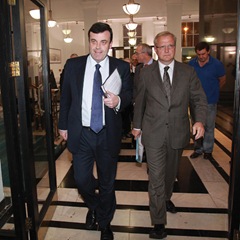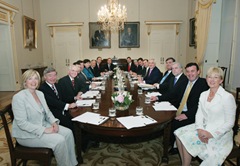A government in review
 As the 30th Dáil reached its final days, the financial and psychological pressure of five budgets in four years was becoming increasingly evident. eolas reviews some of the most important political and social events that shaped the term and the lives of Ireland’s citizens.
As the 30th Dáil reached its final days, the financial and psychological pressure of five budgets in four years was becoming increasingly evident. eolas reviews some of the most important political and social events that shaped the term and the lives of Ireland’s citizens.
From the heady days of fundraising in the tent at the Galway races and using the corporate jet to be dropped at their local airport, to electoral annihilation, the demise of Fianna Fáil represented the culmination of four years of a worsening economic situation and increasing anger towards a government that allowed Ireland to get into this mess.
Unemployment has reached a 16 year high of 13.3 per cent from 4.6 per cent in 2007, approximately 1,000 young people emigrate from the country each week, the deficit stands at €18 billion and the country faces paying interest on an €85 billion EU-IMF loan at 5.8 per cent.
2007
An ambitious National Development Plan was launched in January 2007, promising investment of €184 billion over seven years. Whether the plan was an electioneering tool for the forthcoming general election was uncertain but, a report released in February 2011, reviewing the Department of Finance, shows that Bertie Ahern ignored the advice of his finance officials and dramatically increased the 2007 budget spend in advance of the general election. Ahern and Fianna Fáil were subsequently re-elected on 24 May.
During 2007 Ahern was praised for his work on helping to establish the power- sharing Executive at Stormont, which was restored on 8 May 2007.
2008
Ahern’s 11-year stint as Taoiseach was to end on 6 May 2008. Negative publicity surrounding the Mahon Tribunal’s investigation into his financial affairs brought uncomfortable reminders of the corruption that marked Charles Haughey’s era, therefore Ahern stepped down to be replaced by his Finance Minister, Brian Cowen.
On becoming the twelfth Taoiseach since the foundation of the State, Cowen it was an “honour” that he accepted “with a genuine sense of humility” which was “engendered in large part from a love of Ireland.”
This was followed in June by the ESRI’s prediction that Ireland was heading for its worst recession since the 1980s. In September the CSO confirmed that Ireland was in recession and the Government drafted a bill for a €440 billion bank guarantee.
Budget 2009 was introduced two months early in October, in a bid to tackle the deficit which stood at 14.3 per cent of GDP, higher than Greece or Britain. It further incensed the public, already reacting to the scandal surrounding FÁS Chief Executive Roddy Molloy who resigned in November 2008 after a Garda investigation into how he and fellow FÁS executives spent hundreds of thousands of euro on lavish trips to the USA. He faced a furious backlash from the public when he told RTÉ’s Pat Kenny “at the time we were doing it, it was standard practice.”
The new year began with more bad news as the Government confirmed that Anglo Irish Bank would be nationalised. This followed the Financial Regulator’s revelation in December 2008 that bank Chairman Sean FitzPatrick had moved his personal borrowings (totalling €87 million) into Irish Nationwide and Irish Life and Permanent before the end of each financial year so that they would not be recorded by the auditors. This was investigated by the regulator and subsequently Anglo’s share price fell from a €17.60 high in 2007 to just 32 cent in 2009. The bank was valued at €242 million and FitzPatrick resigned.
The country was faced with an emergency supplementary Budget in April 2009. It outlined a path to reduce the deficit to 3 per cent of GDP by the end of 2013 and forecast that the public finances would need to be corrected by €4 billion in each of the next three years. In July, the Report of the Special Group on Public Service Numbers and Programmes (An Bord Snip Nua) suggested ways of cutting €5.3 billion from the public sector including cutting social welfare payments by five per cent, merging the functions of government departments and reducing public sector pensions and wages.
In November 2009, NAMA was established by the Government to buy the riskiest loans off banks at a reduced price, using government-guaranteed securities. The total amount of loans NAMA will take on will be approximately €80 billion. December’s 2010 Budget outlined €4 billion in cuts including reductions in child benefit and income support, a prescription charge of 50 cent per item and reductions in public service salaries and professional fees.
2010
Towards the end of a year that saw revelations that sex abuse had been endemic in Catholic church-run institutions, severe weather bringing the country to a standstill and a leadership heave against prospective Taoiseach Enda Kenny, rumours persisted that the Government would require financial assistance from the EU and the IMF. These claims were dismissed even as Finance Commissioner Olli Rehn arrived in Ireland to draw up a four-year austerity plan. This was launched by Brian Lenihan and Brian Cowen as a ‘recovery plan’. It would cut expenditure by €10 billion and raise €5 billion in tax.
The arrival of the IMF in late November 2010 cemented the end of the Fianna Fáil-Green coalition. The acceptance of the €85 billion loan was preceded by the revelation in September 2010 that the cost of bailing out Anglo Irish Bank would be €50 billion and that the four-year plan would cut €15 billion in the next four years in order to appease the lenders.
2011
As Cowen came to the end of his tenure he faced revelations in January 2011 of a previously undisclosed meeting between him, the then Chairman of Anglo Irish bank, a former Anglo board member and the former Director of the Central Bank prior to implementing the bank guarantee scheme.
Amid unprecedented scenes in the Dáil on 20 January, with six ministerial resignations and an absent Taoiseach, Enda Kenny called for Brian Cowen to “come to the House to inform the Irish public what is happening in this country.” This was followed by the announcement that a general election was imminent and marathon sessions to get the Finance Bill passed before a new Government was elected.
Despite a tumultuous 21 months as Taoiseach, Cowen’s personal standing was praised and commended by both main opposition leaders as the Dáil reached its dissolution on 1 February.
Programme for Government progress
The 2007 Programme for Government was written in a relatively stable economic climate. It aimed to grow the economy by 4.5 per cent annually (it is now estimated to grow by 2.7 per cent annually) and to deliver the €184 billion National Development Plan (NDP), which included €33 billion for transport infrastructure, over seven years.
However, by October 2009, a renewed programme was drawn up because the 2007 one did not reflect the “current economic realities.”
It would reduce the deficit to 3 per cent of GDP by the end of 2013 by cutting €
4 billion from public finances each year.
Programme for Government commitments that had been achieved by the Dáil’s dissolution include:
• increasing exports (they rose by 7 per cent in real terms in the first half of 2010 and manufacturing was up 12 per cent);
• abolishing the employee PRSI ceiling;
• introducing a carbon tax in Budget 2010;
• maintaining the 12.5 per cent corporation tax; and
• simplifying income tax levies.
Those not achieved include:
• returning the economy to a sustainable position;
• reconfiguring the banking system and restoring it to health; and
• introducing a new system for the financing of local government.
After four years of pay cuts and tax increases, the sense of despair that arrived with the IMF was summed up in a scathing Irish Times editorial on 28 November. “Is this what the men of 1916 died for: a bailout from the German chancellor with a few shillings from the British chancellor on the side? There is the shame of it all.”
13 February 2009
Labour was ahead of Fianna Fáil in the polls for the first time in history.
20 May 2009
The Ryan report caused public outcry.
7 June 2009
European elections:
Fianna Fáil: -7.8%
Green Party: -15%
Fine Gael: +3.8%
Labour: +2.7%
3 October 2009
Ireland voted ‘yes’ in the second Lisbon Treaty referendum.
19 November 2009
Thierry Henry’s double-handball put Ireland out of the 2010 World Cup and further depressed the public.
November 2009
Extreme floods saw families being rescued from their homes. NAMA was established.
December 2009
A drop in temperature brought severe snow and ice with water shortages across the country.
15 February 2010
Pope Benedict called the Irish Catholic Bishops to Rome to discuss the child abuse scandal.
10 March 2010
The HSE launched an investigation into 58,000 un-checked x-rays at Tallaght Hospital.
11 June 2010
Eamon Gilmore was polled as the most popular prospective Taoiseach
29 September 2010
A man was arrested after droving a cement mixer truck with ‘Anglo Toxic Bank’ painted on it into the gates of Leinster House.
25 November 2010
Sinn Féin’s Pearse Doherty won the Donegal South West by-election.
27 November 2010
A crowd of up to 50,000 people marched in protest at the spending cuts and tax increases.
1 February 2011
The Dáil was dissolved and a general election was called for 25 February.






